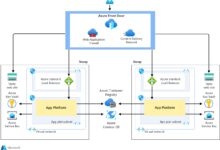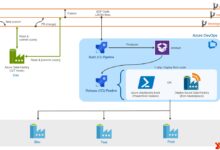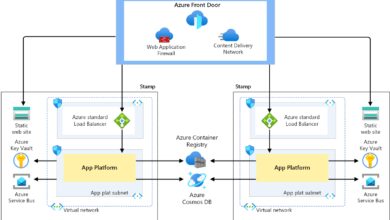Sign In to Azure Portal: 7 Ultimate Tips for Seamless Access
Accessing your cloud resources starts with one crucial step: sign in to Azure portal. Whether you’re a developer, administrator, or IT manager, knowing how to securely and efficiently log in can save time and prevent access issues. Let’s explore everything you need to know.
Understanding the Azure Portal and Why You Need to Sign In
/getty_signs-56af94d63df78cf772c66a19.jpg?w=1200)
The Azure portal is Microsoft’s web-based interface for managing cloud services, virtual machines, storage, networking, and more. It acts as the central command center for all Azure resources. To gain access, you must first sign in to Azure portal using valid credentials.
What Is the Azure Portal?
The Azure portal (portal.azure.com) is a unified console that allows users to deploy, configure, monitor, and manage Azure services through a graphical user interface. It supports role-based access control (RBAC), resource grouping, cost management, and integration with other Microsoft tools like Power BI and Microsoft 365.
- It provides real-time monitoring of cloud infrastructure.
- Supports automation via templates and scripts.
- Offers dashboards for custom views of key metrics.
“The Azure portal is the gateway to your cloud environment—secure access is non-negotiable.” — Microsoft Azure Documentation
Why Signing In Is Essential
Without signing in, you cannot interact with any Azure resources. Authentication ensures that only authorized users can view or modify data, helping maintain compliance and security. Every action taken in the portal is tied to your identity, enabling audit trails and accountability.
- Enables identity verification through Azure Active Directory (Azure AD).
- Grants access based on assigned roles and permissions.
- Allows multi-factor authentication (MFA) for enhanced security.
How to Sign In to Azure Portal: Step-by-Step Guide
Signing in to the Azure portal is straightforward, but understanding each step ensures a smooth experience. Follow this guide to sign in to Azure portal successfully.
Navigate to the Official Login Page
Open your preferred web browser and go to https://portal.azure.com. This is the official URL for the Azure management portal. Avoid third-party links to prevent phishing risks.
- Ensure the website uses HTTPS and displays a valid security certificate.
- Bookmark the page for quick future access.
- Use modern browsers like Chrome, Edge, or Firefox for best compatibility.
Enter Your Credentials
On the login screen, enter your work or school account email address associated with Azure. This is typically in the format username@yourcompany.com or username@yourdomain.onmicrosoft.com.
- If you’re using a personal Microsoft account, ensure it has been granted access to an Azure subscription.
- Azure does not support local Windows accounts unless federated through Azure AD.
- After entering the email, click “Next” to proceed.
Complete Authentication and Access Dashboard
After entering your password, you may be prompted for additional verification if multi-factor authentication (MFA) is enabled. This could include:
sign in to azure portal – Sign in to azure portal menjadi aspek penting yang dibahas di sini.
- Approving a notification via the Microsoft Authenticator app.
- Entering a code sent via SMS or email.
- Using a hardware security key.
Once authenticated, you’ll be redirected to the Azure dashboard, where you can begin managing resources.
Common Issues When Trying to Sign In to Azure Portal
Even with correct credentials, users often face obstacles when trying to sign in to Azure portal. Identifying these issues early can reduce downtime and frustration.
Incorrect Username or Password Errors
This is the most common login problem. Causes include typos, caps lock being enabled, or using the wrong account type (e.g., personal vs. work account).
- Double-check the email format and spelling.
- Use the “Forgot password?” link to reset if needed: https://passwordreset.microsoftonline.com.
- Ensure you’re not locked out due to multiple failed attempts.
Multi-Factor Authentication Failures
MFA enhances security but can cause access delays. Users might not receive codes, lose their authenticator device, or have outdated app settings.
- Verify your phone number and email are up to date in Azure AD profile.
- Re-register the Microsoft Authenticator app if synchronization fails.
- Contact your administrator if backup methods are required.
Account Locked or Disabled
Sometimes, accounts are disabled by administrators or locked due to suspicious activity.
- Check with your IT department to confirm account status.
- Review sign-in logs in Azure AD for alerts or blockages.
- Wait for automatic unlock periods (usually 30–60 minutes after repeated failures).
Security Best Practices When Signing In to Azure Portal
Securing your login process is critical when you sign in to Azure portal, especially in enterprise environments. A compromised account can lead to data breaches or unauthorized resource usage.
Enable Multi-Factor Authentication (MFA)
MFA adds an extra layer of protection beyond passwords. Even if credentials are stolen, attackers cannot access the account without the second factor.
- Administrators should enforce MFA via Conditional Access policies.
- Use the Microsoft Authenticator app for push notifications.
- Register multiple verification methods (phone, email, app) for redundancy.
“Over 99.9% of account compromises can be prevented by enabling MFA.” — Microsoft Security Report
Use Strong, Unique Passwords
A strong password is at least 12 characters long and includes uppercase, lowercase, numbers, and symbols. Avoid reusing passwords across platforms.
sign in to azure portal – Sign in to azure portal menjadi aspek penting yang dibahas di sini.
- Consider using a password manager like Microsoft Edge Password Monitor or Bitwarden.
- Change passwords periodically, especially after suspected exposure.
- Avoid dictionary words or personal information (birthdates, names).
Leverage Conditional Access Policies
Conditional Access in Azure AD allows organizations to define rules for when and how users can sign in to Azure portal.
- Restrict access based on user location (IP address).
- Require compliant devices (Intune-managed) for access.
- Block legacy authentication protocols (e.g., IMAP, SMTP).
These policies help ensure that only trusted users from secure environments can access sensitive resources.
Using Single Sign-On (SSO) to Simplify Access
For organizations with multiple cloud applications, setting up Single Sign-On (SSO) streamlines the process to sign in to Azure portal without repeated logins.
What Is SSO and How It Works
Single Sign-On allows users to authenticate once and gain access to multiple systems without re-entering credentials. In Azure, SSO is managed through Azure Active Directory.
- Users log in to their corporate network or identity provider (IdP).
- Azure AD validates the session and grants access to the portal.
- Seamless integration with apps like Office 365, Salesforce, and Dropbox.
Configuring SSO for Azure Portal Access
Administrators can configure SSO via the Azure portal under Azure Active Directory > Enterprise Applications.
- Choose between SAML, OAuth, or OpenID Connect protocols.
- Upload metadata or configure manually with endpoints and certificates.
- Test the configuration using the “Test sign-on” feature.
Detailed setup guides are available at Microsoft Learn: Single Sign-On Overview.
Benefits of SSO for Enterprises
Implementing SSO offers several advantages:
- Reduces password fatigue and improves user productivity.
- Enhances security by centralizing authentication control.
- Enables better auditing and compliance reporting.
- Lowers helpdesk costs related to password resets.
Managing Multiple Azure Subscriptions During Login
Many users have access to multiple Azure subscriptions, which can complicate navigation after you sign in to Azure portal. Proper management ensures you’re working in the correct environment.
sign in to azure portal – Sign in to azure portal menjadi aspek penting yang dibahas di sini.
Switching Between Subscriptions
After logging in, use the subscription filter at the top of the portal to switch between available subscriptions.
- Click your profile icon > “Switch directory” or “Change directory”.
- Select the desired subscription from the dropdown menu.
- The portal interface updates to reflect resources in the selected subscription.
Understanding Subscription Roles and Permissions
Your access level depends on the roles assigned within each subscription (e.g., Owner, Contributor, Reader).
- Owners can manage all resources and assign roles.
- Contributors can create and modify resources but cannot grant access.
- Readers can view resources but not make changes.
Check your permissions under “Access control (IAM)” in each subscription.
Using Azure CLI or PowerShell for Subscription Management
For advanced users, command-line tools offer efficient subscription switching.
- In Azure CLI:
az account set --subscription "Subscription Name" - In PowerShell:
Select-AzSubscription -SubscriptionId "xxxx-xxxx" - List all accessible subscriptions with
az account listorGet-AzSubscription.
This is especially useful for automation and scripting tasks.
Advanced Access Methods: Guest Users and B2B Collaboration
Organizations often need external partners to sign in to Azure portal for collaboration. Azure B2B (Business-to-Business) enables secure guest access.
Inviting Guest Users to Azure Portal
Administrators can invite external users via email through Azure AD.
- Go to Azure Active Directory > Users > New user > Invite external user.
- Enter the guest’s email and assign a role (e.g., Guest, Contributor).
- The guest receives an invitation link to complete registration.
Learn more at Microsoft Learn: Add B2B Guest Users.
sign in to azure portal – Sign in to azure portal menjadi aspek penting yang dibahas di sini.
Guest User Sign-In Experience
Guests sign in using their home organization’s credentials (federation) or a one-time passcode.
- If their company uses Azure AD, they authenticate there and are redirected.
- If not, they may use a temporary code sent to their email.
- Once logged in, they see only the resources they’ve been granted access to.
Managing Guest Access and Security
While B2B collaboration is powerful, it introduces potential risks.
- Set expiration dates on guest invitations to limit long-term access.
- Monitor guest activity in Azure AD sign-in logs.
- Apply Conditional Access policies specifically for guest users.
Regular audits help maintain a secure collaborative environment.
Troubleshooting Persistent Login Problems
Even after following best practices, some users continue to face issues when trying to sign in to Azure portal. Here’s how to resolve them systematically.
Clear Browser Cache and Cookies
Stored data can interfere with authentication sessions.
- Clear browsing data in Chrome: Settings > Privacy and security > Clear browsing data.
- In Edge: Settings > Privacy, search, and services > Clear browsing data.
- Try an in-private or incognito window to test.
Try a Different Browser or Device
Isolation testing helps identify client-side issues.
- Attempt login from another browser (e.g., switch from Firefox to Edge).
- Use a different device or network to rule out local restrictions.
- Ensure JavaScript and cookies are enabled.
Contact Your Administrator or Microsoft Support
If all else fails, escalate the issue.
- Check if your account is licensed for Azure access.
- Verify that your directory is healthy and synchronized (for hybrid setups).
- Open a support ticket via the Azure portal (if accessible) or through your organization’s IT helpdesk.
Microsoft offers various support plans: Azure Support Options.
sign in to azure portal – Sign in to azure portal menjadi aspek penting yang dibahas di sini.
Optimizing Your Azure Portal Experience After Signing In
Successfully signing in is just the beginning. Enhancing your post-login experience improves productivity and control over your cloud environment.
Customize Your Dashboard
The Azure dashboard is fully customizable to display the most relevant information.
- Add tiles for VMs, databases, cost analysis, or alerts.
- Resize and rearrange widgets for optimal layout.
- Save multiple dashboards for different roles or projects.
Use Quickstart Templates and Automation
Leverage pre-built templates to deploy resources quickly after logging in.
- Search for templates in the Azure Marketplace.
- Deploy with ARM (Azure Resource Manager) templates for consistency.
- Automate repetitive tasks using Logic Apps or Azure Functions.
Monitor Usage and Costs
After you sign in to Azure portal, review the Cost Management + Billing section.
- Set up budgets and alerts to avoid overspending.
- Analyze spending by resource, department, or tag.
- Download invoices and usage reports for auditing.
Proactive cost monitoring ensures financial accountability in the cloud.
How do I sign in to the Azure portal?
To sign in to the Azure portal, go to https://portal.azure.com, enter your work or school email address, input your password, and complete any additional authentication steps like multi-factor authentication (MFA). Once verified, you’ll be directed to your dashboard.
What should I do if I forget my Azure portal password?
sign in to azure portal – Sign in to azure portal menjadi aspek penting yang dibahas di sini.
If you forget your password, click “Forgot password?” on the login screen and follow the prompts to reset it. You’ll need access to your recovery email, phone, or authenticator app. If you’re using a work account, contact your administrator for assistance.
Can I access Azure portal without multi-factor authentication?
While you can technically sign in without MFA if it’s not enforced, Microsoft strongly recommends enabling it for security. Administrators can require MFA through Conditional Access policies in Azure AD.
Why can’t I see my subscription after signing in?
If you can’t see your subscription, you may not have the necessary permissions or you’re in the wrong directory. Click your profile icon, select “Switch directory”, and choose the correct one. Contact your administrator to confirm your access rights.
Is it safe to sign in to Azure portal from public networks?
It’s not recommended to sign in to the Azure portal from public or unsecured Wi-Fi networks. Use a trusted, private connection and ensure your device is secure. Always log out after use, especially on shared devices.
Signing in to the Azure portal is the essential first step in managing your cloud infrastructure. From navigating the login page to troubleshooting access issues and enhancing security, every aspect plays a role in maintaining a smooth and secure experience. By following best practices like enabling MFA, using SSO, and managing subscriptions effectively, you can maximize productivity and minimize risks. Whether you’re an administrator, developer, or guest user, understanding how to properly sign in to Azure portal empowers you to take full control of your cloud journey.
sign in to azure portal – Sign in to azure portal menjadi aspek penting yang dibahas di sini.
Recommended for you 👇
Further Reading:









